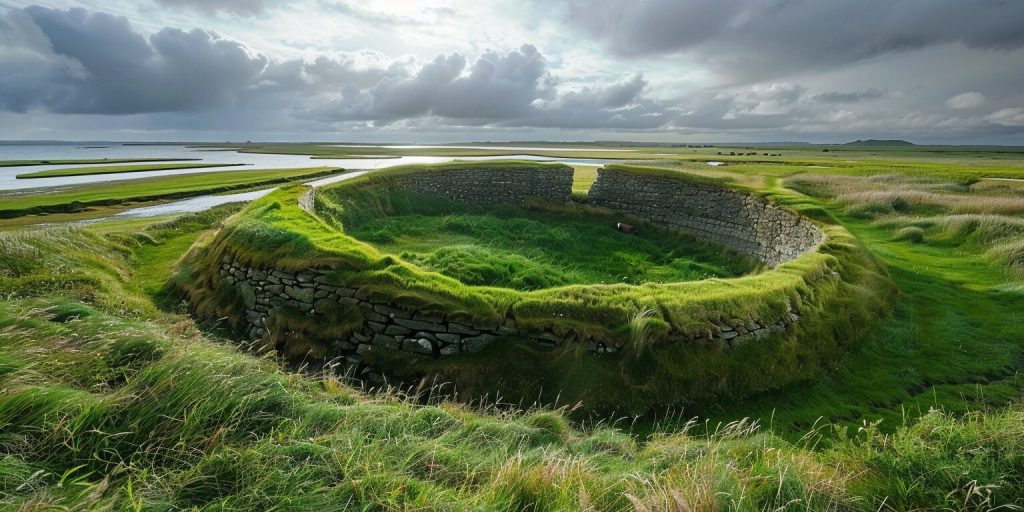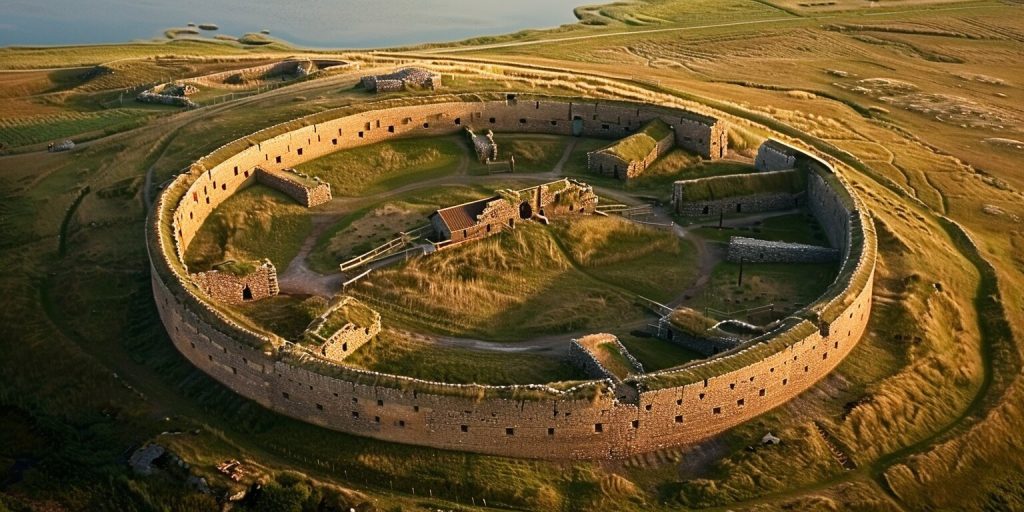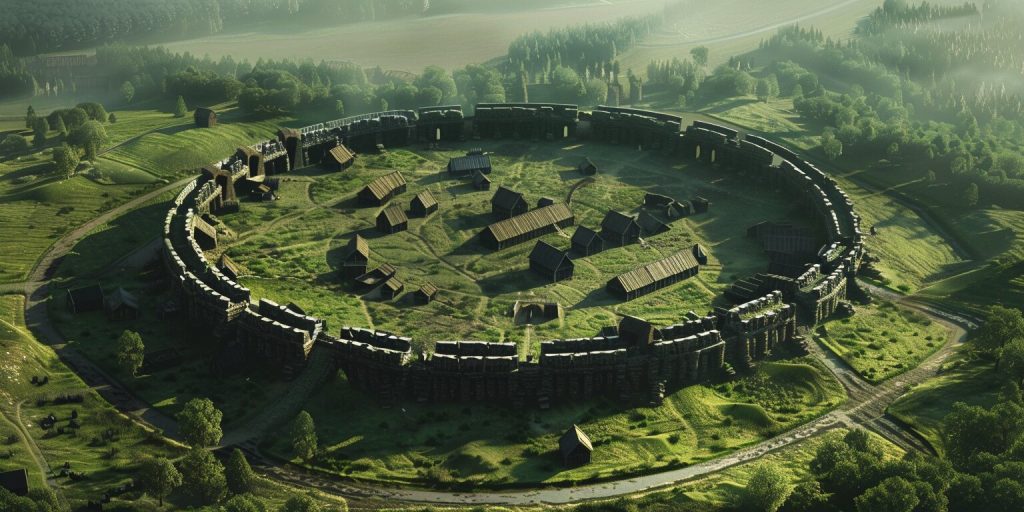Daily Life in the Viking Age, Vikings
Did Vikings Have Castle?
The idea of a Nordic Viking castle is often seen as a myth but based on truth. Archaeologists and historical records show that Vikings built fortress-like structures in Northern Europe, some of which were connected to leaders like Harald Bluetooth. These structures ranged from ring fortresses to fortified settlements, showing their skill in building defenses.
These Scandinavian fortresses were key to the Norse world in the Viking age. They changed the view of Vikings as just raiders. These medieval Viking strongholds were found in many places, showing the Vikings’ complex society and strategic skills.
What Were Viking Castles?
Viking castles, also known as “Trelleborg,” were key during the Viking Age. They were built as strong defenses and places for leaders to govern from the castle’s central halls. Their design and purpose tell us a lot about Viking culture and battles.
Definition and Purpose of Viking Castles
A Trelleborg was a fortress meant for protection and control. It had strong walls and a deep moat for safety. These castles were also important for planning battles and ruling over lands.
Architecture and Layout of Viking Castles
Norse castles were built in a circle. They had a central courtyard with wooden buildings and several gates, elements typical of a Viking fortress. The round walls and moats made them very hard to breach, making them strong defenses.
Excavation Discoveries in Viking Castles
Archaeologists have found many Viking castles in Denmark, each adding to our understanding of Harald Bluetooth’s reign and Viking society. They’ve uncovered wooden buildings, gates, and other parts of the Trelleborg, many of which are now displayed in a museum. These finds tell us about life inside these strongholds and their importance in Viking times.
Where Were Viking Castles Located?
Nordic Viking castles were key to the Viking Age’s strategy and defense. Many were in Denmark, showing off Viking engineering and military skills. Castles like Fyrkat were built to control areas and protect Viking people.
Locations of Viking Castles in Denmark
Castles like Fyrkat and Trelleborg in Denmark show the Vikings’ fortification skills. Fyrkat stands out with its perfect circle and strong build, a testament to the architectural prowess of Viking fortresses. These castles were in important spots to watch over trade and military paths.

Comparison Between Viking Castles in Denmark and Other Countries
The Norse castles in Norway, Denmark, and Sweden show similarities and differences. They often had circular walls and central halls, with some castles with impressive diameters showcasing their might. However, the design changed based on the land and the defensive needs specific to each Viking fortress. For example, Sweden’s forests led to certain castle designs, while Norway’s tough land helped make their castles stronger.
- Strategic Placement: Viking castles in Denmark, Sweden, and Norway were placed to control and watch over areas well.
- Architectural Adaptation: The design of each castle changed based on the local land and culture, showing the Vikings’ clever use of resources.
Studying Viking castles in Sweden, Norway, and Denmark teaches us about their adaptability and strategy during the Viking Age.
Why Were Viking Castles Built?
Viking castles were key to protecting their lands from threats, whether from nearby towns or further afield. They were not just simple fortresses but complex structures often exhibited in museums today. They were smartly built to control important areas, and these castles showed the Vikings’ skill in both war and building.
Strategic Importance of Viking Castles
Viking castles were built in strategic spots, often in or near key towns. They watched over vital trade paths, keeping the economy and borders safe. They also played a big part in ruling the land, helping the Vikings spread their influence and keep their society in order.
Significance of Viking Castles in Defensive Structures
The design of Viking castles was a sign of advanced military planning, reflecting the strategic landscape of medieval Scandinavia. They had circular shapes and many gates, making them hard to breach, with some castles documenting their impressive diameters. These features offered physical defense, scared off attackers, and prevented raids, showing how the Vikings were ready for new military challenges.
What Evidence Exists of Viking Castles?
Exploring the ruins of Viking castles gives us a deep look into their lives and how they built these structures. Archaeological finds tell us a lot about the Vikings and their culture. They show us what life was like back then.
Archaeological Finds in Viking Castles
Archaeologists have found many artifacts in Viking castles through careful digging. They’ve found parts of strongholds, tools, and things people used every day in the castle’s premises. Sites like the Trelleborg fortress and Borgring have been key in learning about Viking life and society.

Heritage and Preservation of Viking Castle Sites
Viking castle sites are very important to our cultural history. They are being protected so they can last. Some Viking castles, like Borgring, are even recognized as UNESCO World Heritage Sites and can be explored near Slagelse. This shows how important it is to keep these places safe for us to learn from in the future.
Summary
The Viking palace is often overshadowed by the Norse’s sea adventures. Yet, it holds a key spot in history, much like the famous Viking fortress of Borgring, which can be visited near the town of Slagelse. These castles were built for defense and to help govern medieval Scandinavia, often serving as a central Viking fortress. Some of them, like the one near Slagelse, are now part of a museum collection. They show the smart planning and culture of the Norse people, with structures like Borgring enhancing our understanding of their strategic ingenuity.
Archaeological discoveries reveal these Viking castles’ importance and role in the Danish landscape. They’ve found many artifacts and structures that help us understand the Norse better. These castles were key in defending against other tribes and threats, showing their vital role in Viking culture and the strategic landscape.
It’s crucial to keep studying and preserving Viking castles, which are often found in towns like Slagelse, to learn more about this fascinating civilization. Exploring these sites reveals the depth of Viking society, including their advanced fortifications like the Borgring. They prove the Norse people’s skills and strength, making their mark on medieval Scandinavia with strong Viking fortresses.

